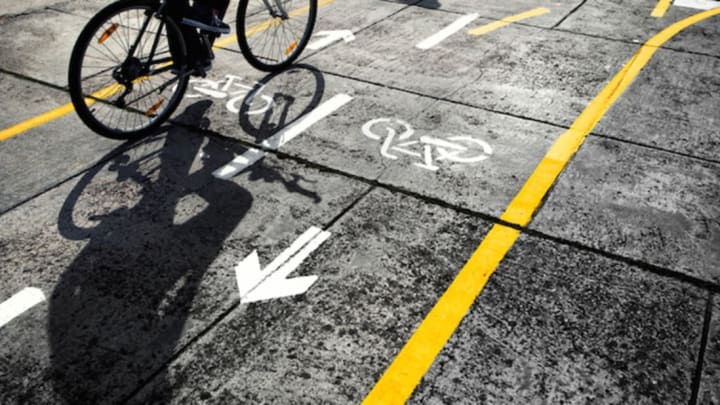Cycling has never been more popular: Upwards of 104 million Americans ride bikes each year. At the same time, more than half of them worry about their safety and the possibility of being hit by a car, according to a survey from Breakaway Research Group [PDF]. But staying safe on your ride is pretty simple as long as you’re paying attention.
“It’s really important to be aware of the people and the traffic around you when you’re on the bike,” says Tim Johnson, Cannondale ambassador and former professional cyclist. “Learning to ride deliberately and defensively is key for staying safe on the bike.” For more tips on how to do that by avoiding flats, falling, and collisions, keep reading.
1. TUNE UP REGULARLY.
If you notice a rusty chain or cracked tire, you definitely want to take your bike to the shop for a tune-up. But it’s a good idea to take it in occasionally even if everything seems A-OK. “Regular checkups are necessary for safety and catching any small problems before they become bigger issues,” says Josh Vick, director of product development for Schwinn. As a general rule, take your bike in for a tune-up at least once a year.
2. PUMP IT UP.
Keeping your wheels at the proper pressure—which varies depending on the type of tire—can make you less likely to get a flat. Consider asking your bike shop about installing tubeless tires on your bike (most bike tires have an inner tube, inside of the rubber casing; the tube is usually what gets a hole and needs to be replaced or patched when you get a flat). “With a tubeless tire, it uses a sealant liquid that will plug any holes automatically,” says Johnson, so you won’t have to stop suddenly or take time to fix the flat.
3. BRAKE WITH BOTH HANDS.
It might seem overkill to clamp down on your brakes with both of your hands, but trying to slow down with only one can set you up for a crash. “Use just the front brake and you might pull too hard, which can cause you to lose control,” says Vick. Likewise, “too much rear brake can cause the bike to skid.”
Also, adds Johnson, make sure your brakes are properly adjusted. “A lot of people have brakes that have fallen out of adjustment, or if a wheel is crooked, the brakes will rub and don’t work as well,” he says. Also, if there’s anything that has lessened traction on the road (like water, sand, or leaves), give yourself more time to brake, so you can do so gradually and avoid skids.
4. LOOK WHERE YOU WANT TO GO.
As a general rule, where you set your sight is the direction your bike will take. “Going into a descent or a turn, the No. 1 thing you can do is look where you’re going,” says Johnson. “If you’re staring at the pavement in front of your front wheel, you don’t see what’s coming around the corner.” He advises scanning far ahead, paying attention for people or cars that might come into your path.
5. FOLLOW TRAFFIC RULES.
Because a bike is smaller, thinner, and less forceful than a car, it’s tempting to think regular traffic laws shouldn’t apply to you. But you want to ride your bike as though you’re driving a car, says Johnson. “Stay in your lane, don’t whip through red lights—because it keeps you safer by letting cars know what to expect. You want to ride in a way that cars can kind of know what you’re up to and you can adjust.”
6. KEEP YOUR DISTANCE.
When riding on a busy street or amid other cyclists and pedestrians on a pathway, keeping some space between yourself and others is essential for avoiding a crash. “Using hand signals will help other riders navigate around you, and be sure to also pay attention to other riders’ signals,” suggests Vick. Look ahead for potholes or other obstacles and start swerving around them as soon as possible, says Johnson, to give people behind you time to respond.
7. ASSUME THE POSITION.
How you position yourself on the bike can help you feel stable as your navigate curves in the road and turns. Try to hold the majority of your body weight over the center of the bike, not putting too much pressure forward on the handlebars, says Johnson: “Almost all of your weight should be over your two feet.” He suggests thinking about it as though you’re squatting over the bike ever so slightly.
8. GO ON THE DEFENSIVE.
As a rule of thumb, when you’re on the bike, you should imagine you’re invisible. “In the city, ride as if no one ever sees you,” says Johnson. “People who ride in the city successfully ride with the assumption that no one sees them and if they don’t look out for themselves, they might get hit by a car.”
